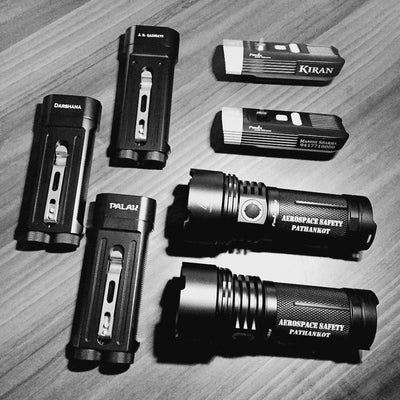Knowledge About LED Flashlights/LED Torch and its Components.

Longevity
The principle behind conventional incandescent technology is based on electrons travelling through a tungsten filament, causing the filament to generate temperatures of up to 2500 Celsius, with light energy merely a byproduct of this process. Due to this inherently inefficient design, incandescent bulbs rapidly deteriorate and burn out after about 1000 hours of use. LED’s, on the other hand, operate on an entirely different principle, and while they do require specialized components to achieve maximum brightness, a working lifespan up to 50,000 hours is possible, with a gradual fading of brightness rather than instant burn-out.
Durability
Due to the absence of a delicate filament and thin glass bulb, LEDs can withstand shock and vibration far beyond that tolerated by incandescent lamps making them ideal for rugged and demanding applications.
Quick Activation
An incandescent bulb generally takes about 100-300 milliseconds to illuminate once activated, while an LED needs only a few nanoseconds,giving it a significant advantage in highly demanding applications.

With many years of experience in flashlight optical design, custom-engineered high-efficiency alloy reflectors ensure every flashlight emits a balanced beam profile of both flood and throw with minimal loss of light.
All reflectors are protected by AR-coated, anti-scratch mineral glass lenses.
Flashlight reflector: Similar to a domestic lampshade, these reflectors are fixed to an artificial light source (for example, a filament bulb or flash tube) to direct and shape the otherwise scattered light, reflecting it off their concave inner surfaces and directing it towards the scene to be photographed. Although there are a large number of variants, the most common types are:
1. spherical, short-sided, giving a relatively broad spread of light;
2. parabolic, providing a tighter, parallel beam of light.
The reflector factor is the ratio of the illumination provided by a lamp fitted within a reflector to the illumination provided without any reflector fitted. A matte reflector will typically have a reflector factor of around 2, due to its more diffuse effect, while a polished or metallic-finished reflector may have a factor of up to 6


Every flashlight is constructed from light weight, high strength aero-grade aluminium alloy. Additionally, the majority of models are CNC machined from a solid aluminium bar. This manufacturing process gives flashlights their superior shock/impact resistance, with many lights able to withstand being rolled over by car or dropped from several meters onto a hard surface with no performance loss (not recommended as may void warranty). Compared to cheaper and weaker tubular aluminium flashlights produced by the majority of flashlight manufacturers today, We offer significant gains in both ruggedness and performance. Furthermore, all models are treated with a military-spec type III hard anodized finish, making the flashlight surface as tough as diamond, thus protecting it from scratches, abrasions and corrosion.

Why Create Standards
Recently, a need for a standard performance platform for the flashlight industry was recognized. The absence of a consistent performance standard has made it difficult to provide comparable product claims and effectively communicate features and benefits, which consumers use to select the right flashlight for their specific needs. Our research indicates a consistent performance platform would be quite beneficial to help users make the right selection when choosing a flashlight.
In addition, the category is changing rapidly as new companies and products enter the market. Flashlight technology has radically changed and consumers are eager to learn more about these new disruptive technologies.
Current agencies, such as UL (Underwriters Laboratories), do not provide performance standards for flashlights, so major retailer’s that employ testing firms are requesting guidance.
Flashlight Standards
To respond to this need, 14 famous flashlight companies collaborated to write a standard. They included the following products: hand-held/portable flashlights, spotlights, and headlamps.
The ANSI/NEMA FL 1 Standard has been ratified and includes six measures. Each measure is defined, has a test procedure specified, and has an associated icon to use for claims. Standard ratification included voters representing three groups: 1) manufacturers, 2) users, and 3) general interests – one group cannot represent more than 50% of the total ratifying vote.
Here is information that is known from public sources. Performance of flashlights is measured using new batteries included with the light when purchased or, if no batteries are included, the batteries recommended by the packaging. There are six criteria used:


The IP Code (or Ingress Protection Rating, sometimes also interpreted as International Protection Rating) consists of the letters IP followed by two digits or one digit and one letter and an optional letter. As defined in international standard IEC 60529, IP Code classifies and rates the degrees of protection provided against the intrusion of solid objects (including body parts like hands and fingers), dust, accidental contact, and water in mechanical casings and with electrical enclosures. The standard aims to provide users more detailed information than vague marketing terms such as waterproof. However, no edition of the standard is openly published for unlicensed readers. The digits (characteristic numerals) indicate conformity with the conditions summarized in the tables below. Where there is no protection rating with regard to one of the criteria, the digit is replaced with the letter X. Liquid ingress protection Protection of the equipment inside the enclosure against harmful ingress of water.









